
The Battle of Gettysburg was fought July 1–3, 1863, in and around the town of Gettysburg, Pennsylvania, by Union and Confederate forces during the American Civil War. In the battle, Union Maj. Gen. George Meade's Army of the Potomac defeated attacks by Confederate Gen. Robert E. Lee's Army of Northern Virginia, halting Lee's invasion of the North. The battle involved the largest number of casualties of the entire war and is often described as the war's turning point due to the Union's decisive victory and concurrence with the Siege of Vicksburg.
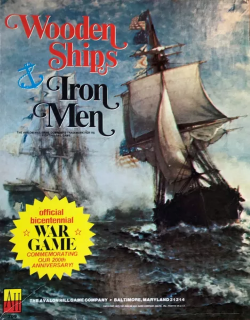
Wooden Ships and Iron Men is a naval board wargame simulating naval combat during the Age of Sail that was published by Battleline Publications in 1974, then revised and republished by Avalon Hill the following year.

PanzerBlitz is a tactical-scale board wargame of armoured combat set in the Eastern Front of the Second World War. The game is notable for being the first true board-based tactical-level, commercially available conflict simulation (wargame). It also pioneered concepts such as isomorphic mapboards and open-ended design, in which multiple unit counters were provided from which players could fashion their own free-form combat situations rather than simply replaying pre-structured scenarios.

The Russian Campaign is a strategic board wargame set in the Eastern Front during World War II, during the period 1941-45. The unit scale is German Corps and Soviet Armies and roughly covers the Berlin to Gorki region and Archangelsk to Grozny. A full campaign game covers the June 1941 to June 1945 period but numerous shorter scenarios are commonly played.
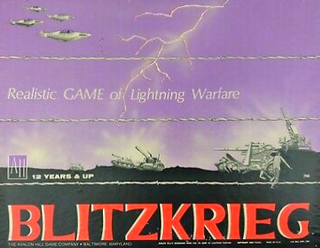
Blitzkrieg is a strategic-level wargame published by Avalon Hill in 1965 that simulates a non-historical attack by one major power against another using blitzkrieg strategy. It was the first commercial wargame that did not simulate an actual historical battle, and with almost 400 counters, it was a precursor of the "monster" wargames of the 1970s featuring more than a thousand counters.

Cemetery Ridge is a geographic feature in Gettysburg National Military Park, south of the town of Gettysburg, Pennsylvania, that figured prominently in the Battle of Gettysburg, July 1 to July 3, 1863. It formed a primary defensive position for the Union Army during the battle, roughly the center of what is popularly known as the "fish-hook" line. The Confederate States Army launched attacks on the Union positions on the second and third days of the battle, but were driven back both times.

Battle of the Bulge is a board wargame published by Avalon Hill as part of the Smithsonian American History Series. The game simulates the World War II battle of the same name and is designed for two players. It is based upon the general Avalon Hill system of combat and movement factors with a focus upon ease of play. The basic rules cover a single sheet of approximately legal-sized paper.

Air Assault on Crete is a wargame published by Avalon Hill in 1977 that simulates the Battle of Crete during World War II.

Tactical wargames are a type of wargame that models military conflict at a tactical level, i.e. units range from individual vehicles and squads to platoons or companies. These units are rated based on types and ranges of individual weaponry. The first tactical wargames were played as miniatures, extended to board games, and they are now also enjoyed as video games.
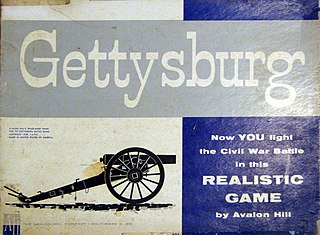
Gettysburg is a board wargame produced by Avalon Hill which re-enacts the American Civil War battle of Gettysburg.
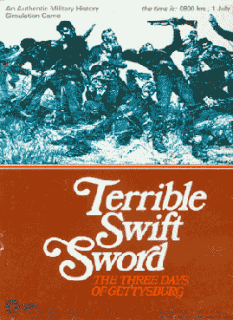
Terrible Swift Sword: Battle of Gettysburg Game is a grand tactical regimental level board wargame published by Simulations Publications, Inc. (SPI) in 1976 that simulates the Battle of Gettysburg during the American Civil War. A second edition was published by TSR in 1986.
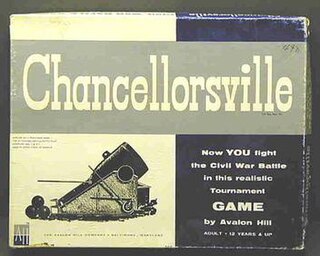
Chancellorsville is a board wargame produced by Avalon Hill in 1961, and republished in 1974 that simulates the Battle of Chancellorsville during the American Civil War.

Neuroshima Hex! is a Polish tactical board game based on the Neuroshima role-playing game. It is published by Wydawnictwo Portal. The game is set in the same post-apocalyptic world as its RPG counterpart.
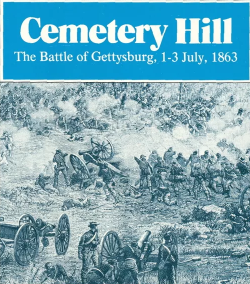
Cemetery Hill, subtitled "The Battle of Gettysburg, 1–3 July 1863", is a board wargame published by Simulations Publications, Inc. (SPI) in 1975 as part of the "quadrigame" Blue and Gray that simulated four battles of the American Civil War. Cemetery Hill was later released as a stand-alone "folio" game.

War and Peace, subtitled Game of the Napoleonic Wars: 1805-1815, is a board wargame published by Avalon Hill in 1980 that simulates ten years of Napoleonic wars.
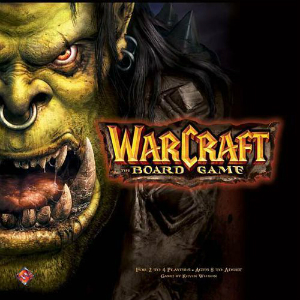
Warcraft: The Board Game is a board game adaptation of the Warcraft series of computer games, created by Kevin Wilson and released in 2003 by Fantasy Flight Games. It takes elements primarily from Warcraft III: Reign of Chaos, but also incorporates elements from Warcraft III: The Frozen Throne.

Armageddon: Tactical Combat, 3000-500 BC is a board wargame first published by Simulations Publications Inc. (SPI) in 1972 in Strategy & Tactics, then released as a stand-alone game, then reimplemented as Chariot: Tactical Warfare in the "Biblical" Age, 3000-500 BC.

Kursk, subtitled "History's Greatest Tank Battle, July 1943", is a board wargame published by Simulations Publications Inc. (SPI) in 1980 that simulates the 1943 Battle of Kursk during World War II. The game proved popular, reaching the top of SPI's Bestseller list, and was well received by critics.
Lee at the Crossroads is a board wargame published by Simulations Canada (SimCan) in 1980 that simulates the 1863 Battle of Gettysburg during the American Civil War. Each player takes the role of one of the opposing commanders, Confederate general Robert E. Lee or Union general George Meade.

Arcola, The Battle for Italy 1796 is a board wargame published by Operational Studies Group (OSG) in 1979 and republished by Avalon Hill in 1983 that is a simulation of the Battle of Arcola between French and Austrian forces in 1796. The game was designed to tempt players to purchase OSG's previously published and larger wargame Napoleon in Italy.



















